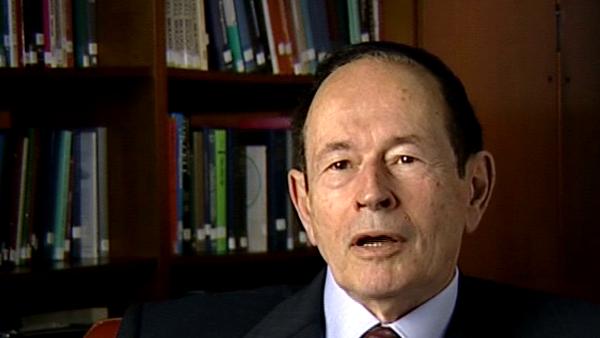NEXT STORY

The Neurosciences Research Program
RELATED STORIES

NEXT STORY

The Neurosciences Research Program
RELATED STORIES


|
Views | Duration | |
|---|---|---|---|
| 31. 'Making an organism is a pretty horrendously complex thing' | 397 | 01:40 | |
| 32. Ed Lewis | 351 | 00:37 | |
| 33. The sciences of recognition and population thinking | 536 | 01:44 | |
| 34. An original thought at Zurich airport | 2 | 676 | 02:52 |
| 35. The Neurosciences Research Program | 561 | 03:53 | |
| 36. Why I don't think the brain is a computer | 1401 | 03:51 | |
| 37. The theory of neural Darwinism | 1 | 1615 | 05:14 |
| 38. The idea of re-entry | 1 | 1094 | 03:40 |
| 39. The idea of value | 800 | 03:43 | |
| 40. Response to criticism of Neural Darwinism | 756 | 05:08 |


The interest in cell adhesion molecules was at its peak in about 1974. I'd spoken about the sciences of recognition which are to my mind evolution itself – development, immunology, and finally the brain... and finally neuroscience. And by that I mean in every case there is a kind of confrontation with an unknown which is solved in one way or another, depending on the mechanics of the system. And I told you that I was deeply influenced by this idea of population thinking, which I think pervades all of these efforts in one way or another, although not everybody would agree with me about that, particularly about the brain. So, as time went on, it became more and more obvious to me that I was going to have to bite the bullet and confront, not only the origin of anatomy which is morphogenesis, but the origin of function and dynamics and all of the things that go along with having a brain. I'd always been interested in this but obviously was filled with trepidation at the thought of having to go near it.
I will date the beginnings of my theoretical interest to an airport crisis which happened in Zurich. In those days we didn't travel as much as we do these days, but a fair amount of my time was spent going back and forth to various places and particularly to Europe, and it was in the Zurich airport that I missed a plane. Now, you have to understand that the texture of travel was quite different then. There was not the same degree of terrorism and fear of it and so you could sort of say, 'Well, you know, I'll wait for another plane.' Well, in this case I couldn't because I'd had the last plane of the day, and I was quite irritated with myself for not showing up on time, but I did have what I think is an original thought. It was: stop being so compulsive, don't worry about going to a hotel; just hang around the airport the way the kids do; sit in a corner and write down your thoughts about the brain. And that's exactly what I did. I stayed there for something like six hours of that effort, and another two hours before I could get another plane. And, in that time, I wrote down what were the skeletal aspects of a theory, a global brain theory. How does the higher order brain work? How does a vertebrate function? And I have to say that this was prompted by two things: the first is my work in embryogenesis which was very focused on the nervous system and on how you made neuroanatomy, and I'll come to that in a moment. The other was the fact that I was a very early member of the Neurosciences Research program.
US biologist Gerald Edelman (1929-2014) successfully constructed a precise model of an antibody, a protein used by the body to neutralise harmful bacteria or viruses and it was this work that won him the Nobel Prize in Physiology or Medicine in 1972 jointly with Rodney R Porter. He then turned his attention to neuroscience, focusing on neural Darwinism, an influential theory of brain function.
Title: An original thought at Zurich airport
Listeners: Ralph J. Greenspan
Dr. Greenspan has worked on the genetic and neurobiological basis of behavior in fruit flies (Drosophila melanogaster) almost since the inception of the field, studying with one of its founders, Jeffery Hall, at Brandeis University in Massachusetts, where he received his Ph.D. in biology in 1979. He subsequently taught and conducted research at Princeton University and New York University where he ran the W.M. Keck Laboratory of Molecular Neurobiology, relocating to San Diego in 1997 to become a Senior Fellow in Experimental Neurobiology at The Neurosciences Institute. Dr. Greenspan’s research accomplishments include studies of physiological and behavioral consequences of mutations in a neurotransmitter system affecting one of the brain's principal chemical signals, studies making highly localized genetic alterations in the nervous system to alter behavior, molecular identification of genes causing naturally occurring variation in behavior, and the demonstration that the fly has sleep-like and attention-like behavior similar to that of mammals. Dr. Greenspan has been awarded fellowships from the Helen Hay Whitney Foundation, the Searle Scholars Program, the McKnight Foundation, the Sloan Foundation and the Klingenstein Foundation. In addition to authoring research papers in journals such as "Science", "Nature", "Cell", "Neuron", and "Current Biology", he is also author of an article on the subject of genes and behavior for "Scientific American" and several books, including "Genetic Neurobiology" with Jeffrey Hall and William Harris, "Flexibility and Constraint in Behavioral Systems" with C.P. Kyriacou, and "Fly Pushing: The Theory and Practice of Drosophila Genetics", which has become a standard work in all fruit fly laboratories.
Tags: 1974
Duration: 2 minutes, 52 seconds
Date story recorded: July 2005
Date story went live: 24 January 2008